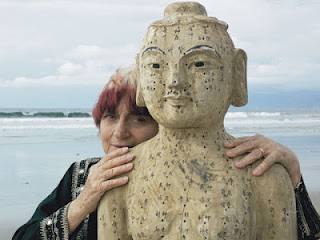'The Film Fathers and the Pregnant Wife’
That’s my mum Winifred (L) pregnant with me, 1948 and Dad, Brian (L) and his dad JL. They are the cinema men exhibiting the American majors (MGM, Paramount, Twentieth Century Fox) and Cinesound & Movietone newsreels across Australian cities and country towns; before that JL exhibited the silents and was Manager of The Capitol Theatre, Melbourne from 1924-1938.
Mum is so vulnerable, her arms protectively crossed across her body, under the gaze of her father in law. These film fathers are part of me, as is our dear Mum, who struggled to find herself and a road to freedom. Memory Film is the story of an inner mind and outer culture (the personal and the political) ebbing and flowing towards freedom - falling apart, falling apart, always falling apart, yet pearls emerging from the mud.
Read more about Memory Film and see it streaming now on SBS On Demand.
The Thornley picture business has had a huge impact on my life. JL (James) our granddad died in Melbourne c1956; that coincided with the arrival of television and the crash of the cinema business. We were in Tasmania and Dad (Brian Thornley) ran the Launceston Plaza and cinemas in Hobart. We moved to Melbourne in 1956 for Dad to take over the family cinema business with his brother. It was a turbulent time!
A man of great vision – bringing over the chariots from the set of the Ten Commandments – and an eye for practical improvements – he patented a device by which a ‘monitor’ in the cinema audience could adjust the volume as each reel was shown as sound varied quite erratically in the early ‘talkie’ years.
He wasn’t always open to changes, though. When the Tivoli Theatre decided (temporarily, due to the outrage that followed) to stop playing the National Anthem after each evening screening because it was usually a signal for the audience to rush to the doors, Mr Thornley refused to end the custom and said: “We don’t find much diving for the aisles…”
In 1936 Thornley went to Hollywood, where he met Bing Crosby, revealing to a magazine after his visit that Mr Crosby had a ‘remarkable knowledge’ of Australian horse-racing. On that same trip he met Cecil B De Mille, who was still making movies in the 1930s.
He retired from his role as manager of the Capitol in 1938".

























